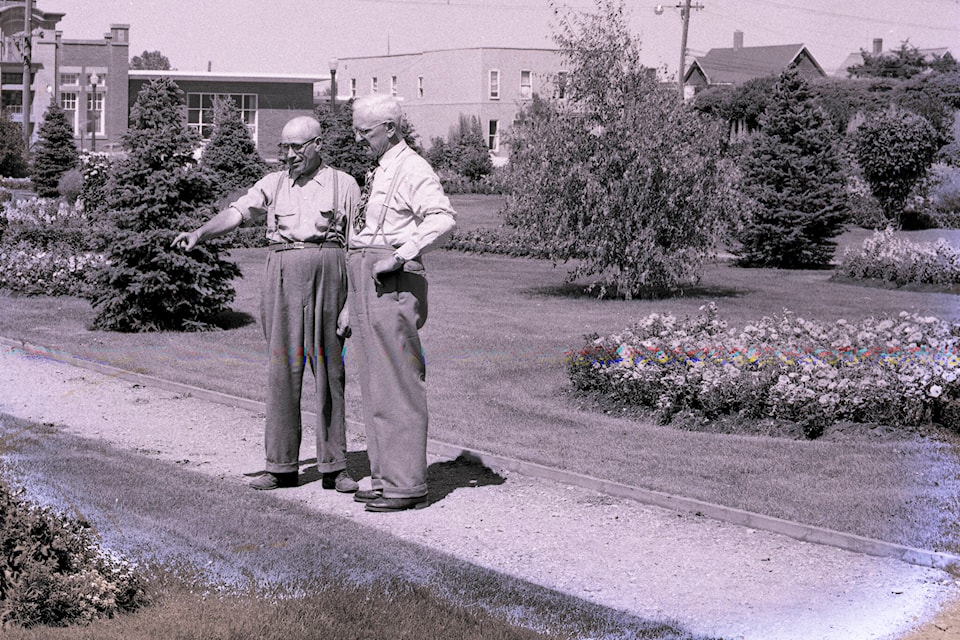This year has been declared the Year of the Garden by the Canadian Garden Council. Red Deer is a fitting place to mark this special event because for many years, the official motto of the community was The Garden City.
One of Red Deer’s most influential residents who helped Red Deer achieve that motto was the City’s long-time horticulturalist and parks superintendent, Hugh Gilchrist.
Hugh Gilchrist was born at Dalbeattie, Kirkcudbrightshire, Scotland on October 8, 1893. In 1914, he immigrated to Canada, settling in Edmonton.
In October 1915, he enlisted with the 51 Battalion in the First World War.
He returned to Canada in 1919 and moved to Red Deer where he got a job as a gardener at the Soldiers’ Sanatorium on the brow of the East Hill, south east of 55 Street and 40 Avenue. He was instrumental in turning the Soldiers’ Hospital grounds into one of Central Alberta’s outstanding beauty spots with its magnificent flower beds and ornamental shrubs and hedges.
He left Red Deer briefly and worked for the Edmonton Parks Department, He later worked for the Provincial Government as a member of the Legislature Buildings Park staff. He returned to the Provincial Training School (now the Michener Centre) and became the head gardener. In 1927, he decided to go into business for himself and started his own florist shop.
Hugh Gilchrist was very active in the community. He was a strong supporter of the Red Deer branch of the Royal Canadian Legion and served on the executive. He also joined the Red Deer Elks Club.
He entered the military again during the Second World War, enlisting in the 41 Battery of the Royal Canadian Artillery in June 1940. He returned from overseas in October 1943, but continued as an artillery instructor.
After the War, he was appointed as the City’s parks superintendent in 1946. He was instrumental in a number of park developments. He designed the small V shaped park at the foot of Michener Hill and named it Victory Park. He redesigned Coronation Park on the north side of Ross Street with ornamental groves of trees interspersed with broad grassy areas, which he dubbed “romping spaces”. He also redesigned the Red Deer Cemetery turning it into a real beauty site with curved pathways and shaped evergreen trees.
He had many of the maple trees removed from the City boulevards, as he disliked the large quantities of seeds they produced and the black stains they left on the sidewalks. He replaced them with topiary spruce trees and elms.
Hugh Gilchrist’s greatest achievement was the design of City Hall Park in 1949-50. Previously, the space had been a large open square, used for public assemblies and sporting events in the summer and as a skating rink area in the winter. Hugh Gilchrist proposed turning the area into an ornamental park, with masses of flowers, shrubs and trees.
His proposal was initially a controversial one. Some people felt that the $1800 cost was excessive. Others felt that the square was better used as a sports field. The plans were finally approved by City Council by a margin of only one vote. However, today we would recognize Hugh Gilchrist’s proposal as truly visionary as City Hall Park has become the “Crown Jewel” of Red Deer’s downtown core.
One aspect of the plans was never carried out. The park was laid out in spoke pattern with the centre hub set as a site for the Cenotaph. The proposal to move the Cenotaph was defeated in a plebiscite held in 1953.
Poor health forced Mr. Gilchrist’s retirement as City Parks Superintendent in March 1961. He was later to receive many honours. He was made a life member of Legion and the Elks Lodge. He was also given a life membership in the Red Deer Horticultural Society, which he has helped to reorganize in the 1950’s and for whom he had been a judge for a great many years.
In 1967, Hugh Gilchrist was given the Centennial Medal for his outstanding work as a horticulturist and parks designer.
Hugh Gilchrist passed away on November 3, 1988 at the age of 95. Gilchrist Crescent in the Glendale subdivision is named in his honour.
Michael Dawe is a Red Deer historian and it appears on Wednesdays.
